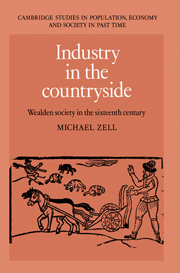Book contents
- Frontmatter
- Contents
- List of figures
- List of tables
- Acknowledgements
- List of abbreviation
- 1 Introduction
- 2 Landholding, inheritance and the local land market
- 3 Demographic movements, household structure and geographical mobility
- 4 The Wealden agrarian regime
- 5 Occupational structure and levels of wealth in the Weald
- 6 The textile industry in the Weald
- 7 Clothiers and capitalism
- 8 The Weald and ‘proto-industrialization’
- Bibliography
- Index
- Cambridge Studies in Population, Economy and Society in Past Time
3 - Demographic movements, household structure and geographical mobility
Published online by Cambridge University Press: 13 October 2009
- Frontmatter
- Contents
- List of figures
- List of tables
- Acknowledgements
- List of abbreviation
- 1 Introduction
- 2 Landholding, inheritance and the local land market
- 3 Demographic movements, household structure and geographical mobility
- 4 The Wealden agrarian regime
- 5 Occupational structure and levels of wealth in the Weald
- 6 The textile industry in the Weald
- 7 Clothiers and capitalism
- 8 The Weald and ‘proto-industrialization’
- Bibliography
- Index
- Cambridge Studies in Population, Economy and Society in Past Time
Summary
The Weald was a wood-pasture island within the sea of lowland England, set apart from the prevailing landscape of nuclear villages which were mainly settled before the Norman conquest. The wood-pasture regions were very thinly settled in the Middle Ages and contained extensive forests and wastes. The emphasis of woodpasture fanning was, as the name implies, biased towards livestock husbandry rather than cereal production. Such regions – and the Weald is typical – had weak structures of seigniorial authority, and thus were attractive to immigrants from other parts of the country when demographic expansion began afresh at the end of the fifteenth or early sixteenth century. Applied specifically to the Kent Weald, this model would assume that the region was underpopulated in the fifteenth century, but became crowded in the following period as the ‘surplus’ population of lowland England in general migrated to the Weald (and other wood-pasture districts) in search of the land which historians have often assumed was there for the taking. But, as we have seen, there was little ‘free’ land in the Kent Weald, in the sense of being open and available for migrant settlement.
One other element has to be added to our model: rural industries. The woodpasture districts became the sites of a variety of manufacturing trades, ranging from metal crafts to textile manufacture, normally organized as domestic production, and frequently controlled by entrepreneurs through a putting out system. The regions' attractiveness to rural manufacturing is usually explained in terms of a combination of natural and social factors.
- Type
- Chapter
- Information
- Industry in the CountrysideWealden Society in the Sixteenth Century, pp. 52 - 87Publisher: Cambridge University PressPrint publication year: 1994



